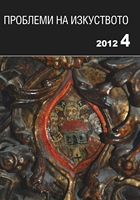Нови данни за изобразителния култ към Св. Седмочисленици през ХVІІІ-ХІХ век на територията на съвременна Албания
New Data on the Visual Cult of the Holy Heptarithmoi in the 18th – 19th Century in the Territory of Present day Albania
Author(s): Ralitsa RussevaSubject(s): Fine Arts / Performing Arts
Published by: Институт за изследване на изкуствата, Българска академия на науките
Summary/Abstract: I express deep appreciation to Albanian restorer Zamir Marika for his selfless help, which made this study possible. This article deals with a few unknown representations of the Holy Heptarithmoi (the Seven Slavic Saints), as well as of St John Vladimir and of New Martyr St Nicodemos of Vithkuq by icon-painters of the Chetiri family (John, George, Nahum, Nicholas) at the churches of St Nicholas (1795) in the village of Vanaj; of the Annunciation (1806) in the village of Kozare and on the iconostasis of the Church of the Assumption in Berat. These have been explored in the context of and in relation to the images of the Holy Heptarithmoi, painted by the family of Constantine and Athanasios from Korçë. Brought together, the works by these two fami- lies of icon-painters outline a particular geographical region (Muzakia) and a timeline scope, where images of the Holy Heptarithmoi have been heavily present. According to the study, the activity of the Bishops of Berat also underlay this process. In the second half of eighteenth century, in the monuments of the territory of Albania a general iconographic scheme of the composition of the Holy Heptarithmoi was formed, which underwent some internal variations. The representation of the Holy Heptarithmoi has already found its per- manent place in the ‘topography’ of churches: on the western wall of the naos, next to the entrance, as protectors and patrons of the Church area. On the monuments under consideration the images of St John Vladimir and of St Nicodemos of Vithkuq also have a permanent place in the iconographic programme of the churches: on the north wall amidst the standing saints. The images under review fill in the gaps in the chronology and development of the Holy Heptarithmoi’s iconography, enriching the overall picture we have for the Arts as well as for the general histori- cal trends of the given period.
Journal: Проблеми на изкуството
- Issue Year: 2012
- Issue No: 4
- Page Range: 20-27
- Page Count: 8
- Language: Bulgarian
- Content File-PDF

